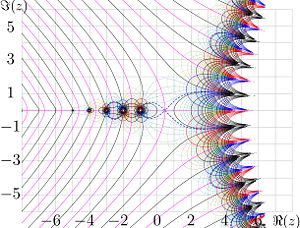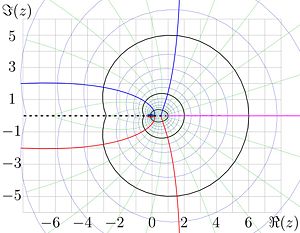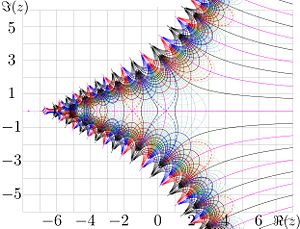Factorial
In mathematics, the factorial is the meromorphic function with fast grow along the real axis. Frequently, the postfix notation Failed to parse (SVG (MathML can be enabled via browser plugin): Invalid response ("Math extension cannot connect to Restbase.") from server "https://wikimedia.org/api/rest_v1/":): {\displaystyle n!} is used for the factorial of number Failed to parse (SVG (MathML can be enabled via browser plugin): Invalid response ("Math extension cannot connect to Restbase.") from server "https://wikimedia.org/api/rest_v1/":): {\displaystyle n} . For integer values of Failed to parse (SVG (MathML can be enabled via browser plugin): Invalid response ("Math extension cannot connect to Restbase.") from server "https://wikimedia.org/api/rest_v1/":): {\displaystyle n} , the factorial, denoted with , gives the number of ways in which n labelled objects (for example the numbers from 1 to n) can be arranged in order. These are the permutations of the set of objects. In some programming languages, both n! and factorial(n) , or Factorial(n), are recognized as the factorial of the number Failed to parse (SVG (MathML can be enabled via browser plugin): Invalid response ("Math extension cannot connect to Restbase.") from server "https://wikimedia.org/api/rest_v1/":): {\displaystyle n} .
Integer values of the argument
For integer values of the argument, the factorial can be defined by a recurrence relation. If n labelled objects have to be assigned to n places, then the n-th object can be placed in one of n places: the remaining n-1 objects then have to be placed in the remaining n-1 places, and this is the same problem for the smaller set. So we have
- Failed to parse (SVG (MathML can be enabled via browser plugin): Invalid response ("Math extension cannot connect to Restbase.") from server "https://wikimedia.org/api/rest_v1/":): {\displaystyle n! = n \cdot (n-1)! \,}
and it follows that
- Failed to parse (SVG (MathML can be enabled via browser plugin): Invalid response ("Math extension cannot connect to Restbase.") from server "https://wikimedia.org/api/rest_v1/":): {\displaystyle n! = n \cdot (n-1) \cdots 2 \cdot 1 , \,}
which we could derive directly by noting that the first element can be placed in n ways, the second in n-1 ways, and so on until the last element can be placed in only one remaining way.
Since zero objects can be arranged in just one way ("do nothing") it is conventional to put 0! = 1.
The factorial function is found in many combinatorial counting problems. For example, the binomial coefficients, which count the number of subsets size r drawn from a set of n objects, can be expressed as
The factorial function can be extended to arguments other than positive integers: this gives rise to the Gamma function.
Definitions
For complex values of the argument, the combinatoric definiton above should be extended. The factorial can be defined as unique meromorphic function Failed to parse (SVG (MathML can be enabled via browser plugin): Invalid response ("Math extension cannot connect to Restbase.") from server "https://wikimedia.org/api/rest_v1/":): {\displaystyle F} , satisfying relations
- Failed to parse (SVG (MathML can be enabled via browser plugin): Invalid response ("Math extension cannot connect to Restbase.") from server "https://wikimedia.org/api/rest_v1/":): {\displaystyle F(z+1)=(z+1) F(z) }
- Failed to parse (SVG (MathML can be enabled via browser plugin): Invalid response ("Math extension cannot connect to Restbase.") from server "https://wikimedia.org/api/rest_v1/":): {\displaystyle F(0)=1 }
for all complex Failed to parse (SVG (MathML can be enabled via browser plugin): Invalid response ("Math extension cannot connect to Restbase.") from server "https://wikimedia.org/api/rest_v1/":): {\displaystyle z} except negative integer values. This definition is not constructive, and gives no straightforward way for the evaluation. Therefore, the integral representation is used as definition:
Such definition is similar to that of the Gamma function, and leads to the relation
for all complex Failed to parse (SVG (MathML can be enabled via browser plugin): Invalid response ("Math extension cannot connect to Restbase.") from server "https://wikimedia.org/api/rest_v1/":): {\displaystyle z} except the negative integer values and zero.
The definition above agrees with the combinatoric definition for integer values of the argument; at integer Failed to parse (SVG (MathML can be enabled via browser plugin): Invalid response ("Math extension cannot connect to Restbase.") from server "https://wikimedia.org/api/rest_v1/":): {\displaystyle z} , the integral can be expressed in terms of the elementary functions.
Also, the definition agrees with commonly used special values; Failed to parse (SVG (MathML can be enabled via browser plugin): Invalid response ("Math extension cannot connect to Restbase.") from server "https://wikimedia.org/api/rest_v1/":): {\displaystyle 0!=1!=1}
and
, and Failed to parse (SVG (MathML can be enabled via browser plugin): Invalid response ("Math extension cannot connect to Restbase.") from server "https://wikimedia.org/api/rest_v1/":): {\displaystyle 3!=6}
, as it is seen in the fugure at the top. That figure shows the factorial in the complex Failed to parse (SVG (MathML can be enabled via browser plugin): Invalid response ("Math extension cannot connect to Restbase.") from server "https://wikimedia.org/api/rest_v1/":): {\displaystyle z}
plane with
lines of constant and
lines of constant Failed to parse (SVG (MathML can be enabled via browser plugin): Invalid response ("Math extension cannot connect to Restbase.") from server "https://wikimedia.org/api/rest_v1/":): {\displaystyle v=\Im(z!)}
.
The levels u = − 24, − 20, − 16, − 12, − 8, − 7, − 6, − 5, − 4, − 3, − 2, − 1,0,1,2,3,4,5,6,7,8,12,16,20,24 are drown with thick black lines.
Some of intermediate levels u = const are shown with thin blue lines for positive values and with thin red lines for negative values.
The levels v = − 24, − 20, − 16, − 12, − 8, − 7, − 6, − 5, − 4, − 3, − 2, − 1 are shown with thick red lines.
The level v = 0 is shown with thick pink lines.
The levels v = 1,2,3,4,5,6,7,8,12,16,20,24 are drown with thick blue lines. some of intermediate levels v = const are shown with thin green lines.
The dashed blue line shows the level Failed to parse (SVG (MathML can be enabled via browser plugin): Invalid response ("Math extension cannot connect to Restbase.") from server "https://wikimedia.org/api/rest_v1/":): {\displaystyle u=\mu_0}
and corresponds to the value Failed to parse (SVG (MathML can be enabled via browser plugin): Invalid response ("Math extension cannot connect to Restbase.") from server "https://wikimedia.org/api/rest_v1/":): {\displaystyle \mu_0=(x_0)!\approx 0.85}
of the principal local minimum Failed to parse (SVG (MathML can be enabled via browser plugin): Invalid response ("Math extension cannot connect to Restbase.") from server "https://wikimedia.org/api/rest_v1/":): {\displaystyle x_0\approx 0.45}
of the factorial of the real argument.
The dashed red line shows the level and corresponds to the similar value of the negative local extremum of the factorial of the real argument.
Evaluation of the factorial
In principle, the integral representation from the definition above can be used for the evlauation of the factorial. However, such an implementation is not efficient, and is not suitable, when the factorial is used as a component in construction of other functions with complicated representations that involve many evaluations of the factorial. Therefore, the approximations with elementary functions are used.
Historically, one of the first approximations of the factorial with elementary funcitons was the Stirling formula below.
Stirling's formula
For large n there is an approximation due to Scottish mathematician James Stirling
Inverse function
Inverse function of factorial can be defined with equation
- Failed to parse (SVG (MathML can be enabled via browser plugin): Invalid response ("Math extension cannot connect to Restbase.") from server "https://wikimedia.org/api/rest_v1/":): {\displaystyle (\mathrm{ArcFactorial}(z))!=z}
and condition that ArcFactorial is holomorphic in the comlex plane with cut along the part of the real axis, that begins at the minimum of factorial of the real argument and extends to . This function is shown with lines of constant real part Failed to parse (SVG (MathML can be enabled via browser plugin): Invalid response ("Math extension cannot connect to Restbase.") from server "https://wikimedia.org/api/rest_v1/":): {\displaystyle u=\Re(\mathrm{ArcFactorial}(z))} and lines of constant imaginary part Failed to parse (SVG (MathML can be enabled via browser plugin): Invalid response ("Math extension cannot connect to Restbase.") from server "https://wikimedia.org/api/rest_v1/":): {\displaystyle v=\Im(\mathrm{ArcFactorial}(z))} .
Levels Failed to parse (SVG (MathML can be enabled via browser plugin): Invalid response ("Math extension cannot connect to Restbase.") from server "https://wikimedia.org/api/rest_v1/":): {\displaystyle u=1,2,3}
are shown with thick black curves.
Levels Failed to parse (SVG (MathML can be enabled via browser plugin): Invalid response ("Math extension cannot connect to Restbase.") from server "https://wikimedia.org/api/rest_v1/":): {\displaystyle u= 0.2,0.4,0.6,0.8, 1.2,1.4,1.6,1.8, 2.2,2.4,2.6,2.8, 3.2,3.4,3.6 }
are shown with thin blue curves.
Levels are shown with thick blue curves.
Level is shown with thick pink line.
Levels Failed to parse (SVG (MathML can be enabled via browser plugin): Invalid response ("Math extension cannot connect to Restbase.") from server "https://wikimedia.org/api/rest_v1/":): {\displaystyle v=-1,-2,-3}
are shown with thick red curves.
The intermediate levels of constant Failed to parse (SVG (MathML can be enabled via browser plugin): Invalid response ("Math extension cannot connect to Restbase.") from server "https://wikimedia.org/api/rest_v1/":): {\displaystyle v}
are shown with thin dark green curves.
The ArcFactorial has the branch point Failed to parse (SVG (MathML can be enabled via browser plugin): Invalid response ("Math extension cannot connect to Restbase.") from server "https://wikimedia.org/api/rest_v1/":): {\displaystyle z_0 \approx 0.85 } ; the cut of the range of holomorphizm is shown with black dashed line.
The figure shows the mapping ot the complex plane with the factorial function. In particular, factorial maps the unity to unity; two is mapped to two, and 3 is mapped to 6.
Function
The inverse funciton of factorial, id est, Failed to parse (SVG (MathML can be enabled via browser plugin): Invalid response ("Math extension cannot connect to Restbase.") from server "https://wikimedia.org/api/rest_v1/":): {\displaystyle \mathrm{ArcFactorial}(z)=\mathrm{Factorial}^{-1}(z)}
from the previous section, sohuld not be confused with
Failed to parse (SVG (MathML can be enabled via browser plugin): Invalid response ("Math extension cannot connect to Restbase.") from server "https://wikimedia.org/api/rest_v1/":): {\displaystyle f(z)=\frac{1}{z!}=\mathrm{Factorial}(z)^{-1}=\frac{1}{\mathrm{Factorial}(z)}}
shown in the figure at right.
The lines of constant Failed to parse (SVG (MathML can be enabled via browser plugin): Invalid response ("Math extension cannot connect to Restbase.") from server "https://wikimedia.org/api/rest_v1/":): {\displaystyle u=\Re(f(z))}
and
the lines of constant are drawn.
The levels are shown with thick black lines.
The levels Failed to parse (SVG (MathML can be enabled via browser plugin): Invalid response ("Math extension cannot connect to Restbase.") from server "https://wikimedia.org/api/rest_v1/":): {\displaystyle v=-24,-20,-16,-12,-8,-7 ... 7,-1}
are shown with thick red lines.
The level Failed to parse (SVG (MathML can be enabled via browser plugin): Invalid response ("Math extension cannot connect to Restbase.") from server "https://wikimedia.org/api/rest_v1/":): {\displaystyle v=0}
is shown with thick pink line.
The levels Failed to parse (SVG (MathML can be enabled via browser plugin): Invalid response ("Math extension cannot connect to Restbase.") from server "https://wikimedia.org/api/rest_v1/":): {\displaystyle v=1,2, ... 7,8,12,16,20,24}
are shown with thick blue lines.
Some of intermediate elvels Failed to parse (SVG (MathML can be enabled via browser plugin): Invalid response ("Math extension cannot connect to Restbase.") from server "https://wikimedia.org/api/rest_v1/":): {\displaystyle u=}
const are shown with thin red lines for negative values and thin blue lines for the positive values.
Some of intermediate elvels Failed to parse (SVG (MathML can be enabled via browser plugin): Invalid response ("Math extension cannot connect to Restbase.") from server "https://wikimedia.org/api/rest_v1/":): {\displaystyle v=}
const are shown with thin green lines.
The blue dashed curves represent the level Failed to parse (SVG (MathML can be enabled via browser plugin): Invalid response ("Math extension cannot connect to Restbase.") from server "https://wikimedia.org/api/rest_v1/":): {\displaystyle u=1/\mu_0}
and correspond to the positive local maximum of the inverse function of the real argument.
The ref dashed curves represent the level Failed to parse (SVG (MathML can be enabled via browser plugin): Invalid response ("Math extension cannot connect to Restbase.") from server "https://wikimedia.org/api/rest_v1/":): {\displaystyle u=1/\mu_1}
and correspond to the negative local maximum of the inverse function of the real argument.
Failed to parse (SVG (MathML can be enabled via browser plugin): Invalid response ("Math extension cannot connect to Restbase.") from server "https://wikimedia.org/api/rest_v1/":): {\displaystyle f(z)=\frac{1}{z!}} is entire function that grows in the left hand side of the compelx plane and quickly decays to zero along the real axis.
References
- Ronald L. Graham; Donald E. Knuth, Oren Patashnik (1989). Concrete Mathematics. Addison Wesley, 111,332. ISBN 0-201-14236-8.

















